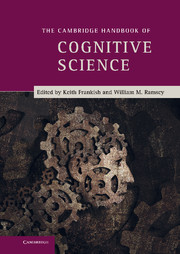
-
Select format
-
- Publisher:
- Cambridge University Press
- Publication date:
- August 2012
- July 2012
- ISBN:
- 9781139033916
- 9780521871419
- 9780521691901
- Dimensions:
- (228 x 152 mm)
- Weight & Pages:
- 0.84kg, 348 Pages
- Dimensions:
- (228 x 152 mm)
- Weight & Pages:
- 0.69kg, 348 Pages
- Collection:
- Cambridge Handbooks of Psychology
You may already have access via personal or institutional login- Collection:
- Cambridge Handbooks of Psychology
Book description
Cognitive science is a cross-disciplinary enterprise devoted to understanding the nature of the mind. In recent years, investigators in philosophy, psychology, the neurosciences, artificial intelligence, and a host of other disciplines have come to appreciate how much they can learn from one another about the various dimensions of cognition. The result has been the emergence of one of the most exciting and fruitful areas of inter-disciplinary research in the history of science. This volume of original essays surveys foundational, theoretical, and philosophical issues across the discipline, and introduces the foundations of cognitive science, the principal areas of research, and the major research programs. With a focus on broad philosophical themes rather than detailed technical issues, the volume will be valuable not only to cognitive scientists and philosophers of cognitive science, but also to those in other disciplines looking for an authoritative and up-to-date introduction to the field.
Reviews
‘Many of the papers will serve as ideal introductions to their given domains and, taken collectively, readers will be given a broad grounding in this fascinating area of study.’
Sam Clarke Source: Philosophical Psychology
Contents
Metrics
Altmetric attention score
Full text views
Full text views help Loading metrics...
Loading metrics...
* Views captured on Cambridge Core between #date#. This data will be updated every 24 hours.
Usage data cannot currently be displayed.
Accessibility standard: Unknown
Why this information is here
This section outlines the accessibility features of this content - including support for screen readers, full keyboard navigation and high-contrast display options. This may not be relevant for you.
Accessibility Information
Accessibility compliance for the PDF of this book is currently unknown and may be updated in the future.


